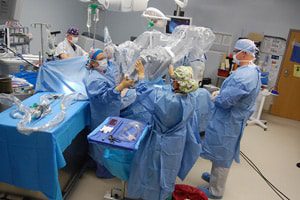
A recent report reveals that adverse reactions associated with da Vinci surgical robot procedures may be greater than believed. The under-reporting of actual patient injuries may be presenting a different picture of the surgical technology to prospective surgical patients. The da Vinci is manufactured and marketed by Intuitive Surgical Inc. For example, in an interview […]
 A recent report reveals that adverse reactions associated with da Vinci surgical robot procedures may be greater than believed. The under-reporting of actual patient injuries may be presenting a different picture of the surgical technology to prospective surgical patients. The da Vinci is manufactured and marketed by Intuitive Surgical Inc.
A recent report reveals that adverse reactions associated with da Vinci surgical robot procedures may be greater than believed. The under-reporting of actual patient injuries may be presenting a different picture of the surgical technology to prospective surgical patients. The da Vinci is manufactured and marketed by Intuitive Surgical Inc.
For example, in an interview conducted by Bloomberg.com, a 45-year-old woman who recently underwent a hysterectomy that utilized the da Vinci robot, alleges she was not told that the system was involved in a number of injuries associated with hysterectomy procedures. The woman, who is suing Intuitive and her physician and says she feels her job may be in jeopardy, alleges she suffered serious rectal burns, is on long-term disability, and will be undergoing a third corrective surgery. “If I had known there were other people who had injuries, I would never have done this surgery…. Whatever they have in place is not working,” she told Bloomberg.com.
In some cases, patients have said that their injuries, which are significant in some cases, do not appear on the U.S. Food and Drug Administration’s (FDA) database. In one case, also involving a hysterectomy, a woman alleges that the da Vinci left a hole in her intestines that was not discovered for two days and which caused her to be hospitalized for four months. “I find it very strange that this has not been reported,” she told Bloomberg.com. A man alleged that he underwent surgery to remove his prostate, which involved the da Vinci robot, and use of the da Vinci technology caused him multiple limb nerve damage, according to papers filed in his lawsuit, wrote Bloomberg.com.
The American College of Obstetricians and Gynecologists recently announced that “Robotic surgery is not the only or the best minimally invasive approach to hysterectomy … nor is it the most cost-effective,” according to a The Wall Street Journal report.
The robotic surgery devices are being used more and more frequently, despite ongoing and mounting litigation and increasing injury reports. In 2012, alone, the da Vinci was utilized in at least 350,000 procedures nationwide, according to Bloomberg.com.
Meanwhile, although a U.S. database lists death and injury reports that are sent to the FDA, the agency may not mandate that physicians provide information on injuries and deaths to that database. As of 1984, however, medical device companies are mandated to report incidents involving their products. According to database data, hundreds of thousands of anonymous reports, which may be made by anyone, may be vague, incomplete, and unverified by the FDA, according to Bloomberg.com. Hospitals are required to submit reports, but do not always do so.
A Bloomberg.com review of da Vinci surgery reports revealed that dozens of injuries have gone unreported for years and that details of patient incidences cited in patient interviews and legal documents were also missing. The Inspector General’s report found that reported incidence numbers are low and dropping—a 37 percent decline was seen from 2003 to 2007—; however, this does not indicate that injury reports are actually on the decline. Rather, it is the reporting of incidents, and not the actual incidents, that appear to be dropping. The low rate “raises concerns about potential under-reporting of adverse events,” the Inspector General wrote. David Challoner, vice president emeritus for health affairs at the University of Florida pointed out that, “Every link in the chain has a reason not to report,” Bloomberg.com reported.


